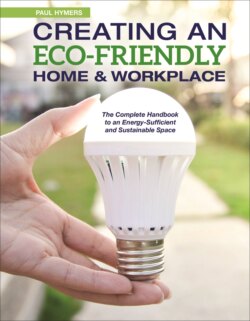Читать книгу Creating an Eco-Friendly Home & Workplace - Paul Hymers - Страница 20
На сайте Литреса книга снята с продажи.
Light source Energy-saving lamps
ОглавлениеJust by changing two filament light bulbs for compact fluorescent ones, you can save the equivalent of 1 tonne of coal from the fire over its lifetime. I’m sure Edison would approve. It was a neat idea of his to heat up a thin wire filament in a glass bulb until it glowed white hot, but really it is time for a change.
Initially that meant going back to gas lights long after Edison got us away from them – CFLs work by using electricity to agitate gas molecules, which then emit light. In this way, the standard CFL bulb burns for 8000 hours, emitting a warm white light with a colour temperature of around the 2700 K mark. This soft light was often misinterpreted as being ‘dim’, even though a 25 watt CFL will produce around 1600 lumens (comparable to the strength of a 100 watt TFL bulb), but it took some time to reach that after warming up. No good if you were half way up the stairs before you could see them.
The reason for this is the low temperature of the light. We have developed a taste for a cleaner, whiter light, more akin to daylight. I strongly believe that it has been, until recently, the light temperature that has put many people off replacing their TFL bulbs with energy-efficient ones. That combined with a restricted availability of compatible decorative fittings, and the fact that you couldn’t use any controls with them beyond a rocker switch. They haven’t been compatible with dimmers and automatic sensors, but recently some manufacturers have cracked those nuts.
UNITS OF LIGHT
Lumen (lm) – luminous power (or lux)
Luminosity or Luminance – the emission or reflectance of light
Efficacy – should be at least 40 for energy efficiency compliance with the Building Regulations in 2017. (The new 2017 generation of LEDs now launched will hit the 200 mark, e.g. 1000 lumens from 5 watt spotlights.)
Candela (cd) – unit of luminous intensity
Lux (lx) – Unit of illumination on a surface (lumen per square metre)
Power – consumption in milliamps (mA)
Watts (W) – power output
Daylight-simulation lamps are now available with a colour temperature between 5000 and 6350 K, similar to daylight with that cooler, bright bluish white light we’ve enjoyed with halogens. If you have yet to replace some power draining spotlights in the kitchen for example, you can now find floodlight reflectors in the daylight group that are still energy-efficient bulbs of up to 40 watts. At this end, they would be equal to 75 watts in a TFL floodlight. That is the top end, brightness-wise; you could come down to 20 watt reflectors if they were carefully directed to reduce your power consumption.
Cool white LEDs are good for task (reading) lighting when they can be focused close to the subject in a narrow beam (e.g. 20–30 degrees).
Different styles for energy-efficient lamps
TYPICAL LAMP PERFORMANCE
LED floodlights are now far superior to the halogen lamps in both energy efficiency, life expectancy and brightness. They’re typically given 100 lumens per watt in the low quality bargain basement end and 200 or more in the latest models. You can interpret ‘lumens’ as brightness.
The warm LEDs of just 3 or 4 watts can be used in bedrooms and dining-rooms where subdued lighting is agreeable. You can find them in decor globe format or swirled into artistic tubular corkscrews, capable of being fitted to a range of light fittings. Replacing your bedroom ceiling lamps with warm white LEDs is the ideal place to start. For reading and in bathrooms, where a cooler light might be better, look for those LEDs with a colour temperature of around 4100 K – not quite daylight, but close.
Controls have been the other big stumbling block with these lamps. We need dimmable lights in most of our reception rooms and bedrooms today, allowing us to adjust the lumen output to suit our mood. Now, it is normal to use dimmable LEDs and even multi-colour changing lamps in both main voltage (24 V) and low voltage (12 V) formats. It is also possible to use them with PIR motion detectors and photoelectric switches that operate at dusk, which means that at last we can have our garden security lights saving energy and money for us rather than burning electricity.
